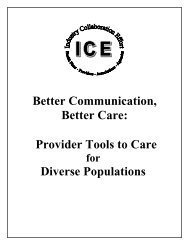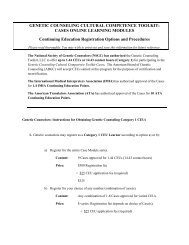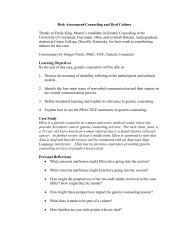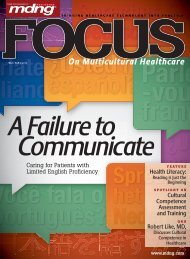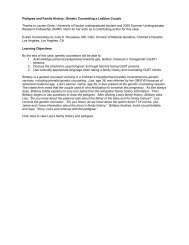Advanced Effective Communication, Cultural Competence, and ...
Advanced Effective Communication, Cultural Competence, and ...
Advanced Effective Communication, Cultural Competence, and ...
Create successful ePaper yourself
Turn your PDF publications into a flip-book with our unique Google optimized e-Paper software.
A Roadmap for Hospitals<br />
Chapter Six: Organization Readiness<br />
Table 6-5. Identifying Vital Documents Appropriate for Translation<br />
Vital Documents<br />
• Informed consent documents<br />
• Complaint forms<br />
• Information about free language assistance programs<br />
or services<br />
• Notices of eligibility criteria for, rights in, denial or loss<br />
of, or decreases in benefits or services<br />
• Intake forms that may have clinical consequences<br />
Non-Vital Documents<br />
• Menus<br />
• Third-party documents, forms, or pamphlets distributed<br />
as a public service<br />
• Large documents such as enrollment h<strong>and</strong>books (although<br />
vital information contained within these documents<br />
may need to be translated)<br />
• General information intended for informational<br />
purposes only.<br />
Source: Adapted from United States Department of Health <strong>and</strong> Human Services, Office for Civil Rights. Guidance to Federal<br />
Financial Assistance Recipients Regarding Title VI Prohibition against National Origin Discrimination Affecting Limited English<br />
Proficient Persons. Washington, DC; 2003. Available at: http://www.hhs.gov/ocr/civilrights/resources/specialtopics/lep/<br />
policyguidancedocument.html. (Accessed March 2, 2010.)<br />
interpreters <strong>and</strong> translators, into new or existing<br />
hospital policies <strong>and</strong> procedures.<br />
• Train staff on how to access language services <strong>and</strong><br />
effectively work with interpreters.*<br />
• Inform patients of their right to receive language services.<br />
• Note the use of language services in the patient’s<br />
medical record.<br />
• Monitor the use of language services.<br />
❑ Address the communication needs of<br />
patients with sensory or communication<br />
impairments.<br />
Although patients with pre-existing hearing, visual, or speech<br />
impairments may arrive at the hospital with their own<br />
communication aids or devices, the hospital may need to<br />
provide auxiliary aids <strong>and</strong> services to facilitate communication<br />
with patients who experience a sensory or communication<br />
impairment due to their current medical condition. †<br />
• Develop a system to provide auxiliary aids <strong>and</strong> services<br />
to address the communication needs of patients with<br />
sensory impairments. Such a system may include sign<br />
language interpreters, telecommunication device for<br />
the deaf (TDD) in public areas, volume control <strong>and</strong><br />
hearing aid adaptable telephones, portable telephones<br />
that can be utilized in patient rooms, closed captioning<br />
services, <strong>and</strong> Braille materials. Select a mixture of<br />
services based on the patient population.<br />
• Incorporate augmentative <strong>and</strong> alternative communication<br />
(AAC) resources into care delivery to address the<br />
needs of patients with communication impairments. Use<br />
a mixture of low, medium, <strong>and</strong> high tech resources to<br />
provide AAC services, including writing pads, pictoral or<br />
communication boards, visual pain scales, speech generating<br />
devices, <strong>and</strong> adaptive nurse call systems.<br />
• Consider developing a communication kit that<br />
includes a combination of writing pads, hearing <strong>and</strong><br />
vision devices, communication displays, or speech<br />
generating devices that is available at each nurses’<br />
station for patients with communication impairments.<br />
• Identify the appropriate AAC resources to meet patient<br />
needs by incorporating referrals to communication<br />
impairment specialists, including speech-language<br />
pathologists <strong>and</strong> audiologists, into patient care.<br />
• Offer a mixture of auxiliary aids <strong>and</strong> services <strong>and</strong> AAC<br />
resources 24 hours a day, 7 days a week.<br />
• Incorporate information about auxiliary aids <strong>and</strong><br />
services information <strong>and</strong> AAC resources into new or<br />
existing hospital policies <strong>and</strong> procedures.<br />
• Train staff on how to access <strong>and</strong> work with auxiliary aids<br />
<strong>and</strong> services <strong>and</strong> AAC resources.<br />
• Note the use of auxiliary aids <strong>and</strong> services <strong>and</strong> AAC<br />
resources in the patient’s medical record.<br />
• Monitor the use of auxiliary aids <strong>and</strong> services or AAC<br />
resources.<br />
* See Appendix E: Resource Guide (page 80) for more information on staff training resources <strong>and</strong> courses.<br />
† See Appendix D: Laws <strong>and</strong> Regulations (page 68) for supporting information on the provision of auxiliary aids <strong>and</strong> services.<br />
41



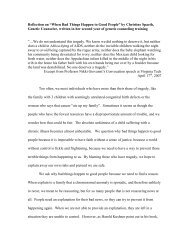
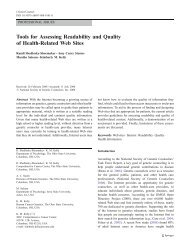

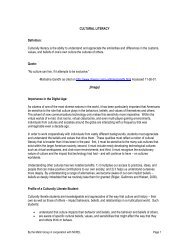
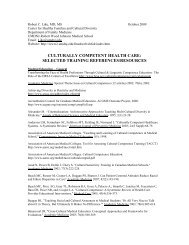

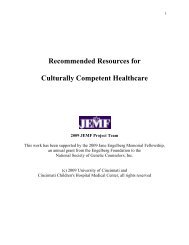

![Breaking Bad News PPT[1] - Genetic Counseling Cultural ...](https://img.yumpu.com/35003134/1/190x146/breaking-bad-news-ppt1-genetic-counseling-cultural-.jpg?quality=85)
